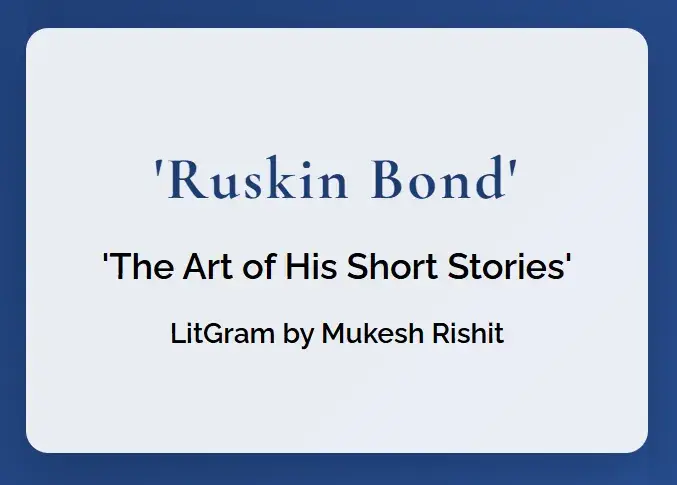Ruskin Bond is one of India’s most treasured literary figures, whose stories have captivated readers for over seven decades. Born on May 19, 1934, in Kasauli, India, Bond has crafted a literary legacy that spans hundreds of short stories, essays, and novels. His simple yet profound writing style, deeply rooted in the natural beauty of the Indian hills, has earned him numerous accolades including the Sahitya Akademi Award, Padma Shri, and Padma Bhushan. This article explores the magical world of Ruskin Bond’s writing, his timeless themes, and why his work continues to resonate with readers of all ages.
The Literary Journey of Ruskin Bond
Early Life and Influences
Ruskin Bond’s childhood was marked by personal hardships that would later shape his literary sensibilities. Born to British parents in pre-independence India, he experienced the painful loss of his father at age 10 and subsequent separation from his mother. These early experiences of loss and loneliness would become recurring themes in his works, expressed with remarkable sensitivity rather than bitterness.
Bond’s formative years were spent in Dehradun, Jamnagar, and Shimla, locations that would later feature prominently in his stories. His deep connection to the Indian landscape, particularly the Himalayan foothills, began during these early years and would become the backdrop for much of his writing.
Literary Career and Evolution
Bond’s literary career began remarkably early when he published his first novel, “The Room on the Roof,” at just 17 years old. This semi-autobiographical work, which won the John Llewellyn Rhys Prize in 1957, introduced readers to Rusty, a character who would appear in several subsequent works. Rusty’s journey mirrors Bond’s own experiences as an Anglo-Indian youth searching for identity and belonging.
After a brief stint in England, Bond returned to India in 1955 and made the permanent decision to live and write in the country he considered home. He settled in Mussoorie in 1963, where he continues to reside today in the hill town of Landour, writing prolifically and drawing inspiration from the mountains, forests, and small-town life that surrounds him.
Notable Works and Their Significance
The Rusty Series
The character of Rusty represents one of Bond’s most enduring literary creations. Featured in works like “The Room on the Roof,” “Vagrants in the Valley,” and “Rusty Runs Away,” this semi-autobiographical character navigates the complexities of adolescence, cross-cultural identity, and the search for independence. Through Rusty, Bond explores themes of friendship, loneliness, and the transition from childhood to adulthood with remarkable authenticity.
Children’s Stories and Novellas
Bond has written extensively for children, producing beloved works like “The Blue Umbrella”, a touching novella about a young girl in a Himalayan village whose prized possession—a beautiful blue umbrella—becomes the object of envy and desire. This simple yet profound story explores themes of materialism, jealousy, and ultimately, compassion and generosity.
“The Cherry Tree” is another cherished work that showcases Bond’s ability to weave meaningful narratives around seemingly simple subjects. The story follows a young boy who plants a cherry seed and watches it grow over the years, paralleling his own growth and learning valuable lessons about patience, nurturing, and the cycles of nature.
Nature and Animal Stories
Bond’s deep connection to the natural world is evident in collections like “The Night Train at Deoli”, where the titular story captures a fleeting romantic encounter at a small railway station, set against the backdrop of the gentle rhythms of small-town India. His stories often feature detailed observations of wildlife, plants, and the changing seasons, demonstrating his profound appreciation for the natural environment.
Themes and Literary Style
Simplicity and Accessibility
One of the most remarkable aspects of Bond’s writing is its deceptive simplicity. His clear, straightforward prose belies the depth of emotion and insight contained within his stories. Bond avoids literary pretension and complicated language, making his work accessible to readers of all ages while still addressing complex themes and emotions.
Nostalgia and Time
Bond’s writing often evokes a sense of nostalgia, not just for a personal past but for a way of life increasingly threatened by modernization. His stories frequently capture moments in time—the India of the 1940s and 50s, small hill stations before mass tourism, and landscapes before extensive development. This nostalgic quality gives his work a timeless appeal while also serving as a gentle critique of unchecked progress.
Human Connections and Loneliness
Throughout his work, Bond explores the fundamental human need for connection. Many of his protagonists are solitary figures—orphans, bachelors, elderly people—who find meaningful connections with others, often across boundaries of age, class, or culture. He portrays loneliness not as something to be feared but as a condition that can lead to self-discovery and deeper connections with both people and nature.
Impact on Indian English Literature
Pioneer of Indian Writing in English
Ruskin Bond began writing at a time when Indian English literature was still in its formative stages. His decision to set his stories in India and portray ordinary Indian life with authenticity and respect helped establish the legitimacy of Indian experiences in English literature. Bond’s work demonstrated that English could be used to express uniquely Indian realities without mimicking Western literary models.
Bridge Between Cultures
As an author of Anglo-Indian heritage who chose to make India his home, Bond’s writing naturally bridges multiple cultural perspectives. His work offers insights into both colonial and post-colonial India, often from the viewpoint of characters who, like himself, exist between worlds. This cultural hybridity gives his writing a unique perspective that resonates with readers from diverse backgrounds.
Influence on Contemporary Writers
Bond’s influence extends to generations of Indian writers who have been inspired by his dedication to craft, his celebration of Indian landscapes, and his ability to address universal themes through local contexts. His straightforward yet evocative prose style has influenced numerous contemporary Indian writers in English, and his success has helped create a market for Indian stories written in English.
Adaptations and Cultural Impact
Film and Television Adaptations
Several of Bond’s works have been adapted for film and television, bringing his stories to even wider audiences. Vishal Bhardwaj’s adaptation of “The Blue Umbrella” (2005) won the National Film Award for Best Children’s Film, while “Junoon” (1979), based on Bond’s novella “A Flight of Pigeons,” is considered a classic of Indian cinema. The television series “Ek Tha Rusty” introduced Bond’s stories to Indian television viewers in the 1990s.
Educational Significance
Bond’s stories are frequently included in school curricula across India, ensuring that new generations continue to discover his work. His accessible style, moral complexity without didacticism, and authentic portrayal of Indian life make his works valuable educational tools for developing both literary understanding and emotional intelligence in young readers.
Cultural Icon Status
Over the decades, Ruskin Bond has transcended his role as an author to become a cultural icon in India. His humble lifestyle in Mussoorie, his continued productivity well into his 80s, and his warmth toward readers have all contributed to his beloved status. For many Indians, Bond represents not just literary excellence but also a certain way of life—contemplative, connected to nature, and finding joy in simple pleasures.
Key Takeaways
- Ruskin Bond’s literary career spans over seven decades, producing hundreds of stories that capture the essence of Indian life, particularly in the Himalayan regions.
- His deceptively simple writing style addresses complex themes of identity, belonging, loneliness, and human connection.
- Bond’s deep appreciation for nature and detailed observations of the natural world are central to many of his works.
- As one of the pioneers of Indian writing in English, Bond helped establish the legitimacy of Indian experiences in English literature.
- His work continues to influence contemporary writers and remains relevant to new generations of readers through school curricula and adaptations.
FAQ: Understanding Ruskin Bond and His Works
What are Ruskin Bond’s most famous works?
Ruskin Bond’s most renowned works include “The Room on the Roof,” “The Blue Umbrella,” “The Night Train at Deoli,” “Time Stops at Shamli,” and “Our Trees Still Grow in Dehra.” His character Rusty appears in several connected works that follow the young Anglo-Indian boy’s coming of age in post-independence India.
What makes Ruskin Bond’s writing style unique?
Bond’s writing is characterized by its clarity, simplicity, and emotional honesty. He avoids literary flourishes in favor of straightforward storytelling that nevertheless captures complex emotions and observations. His descriptions of nature are particularly notable for their precision and sensory detail.
Why is Ruskin Bond important to Indian literature?
As one of the early Indian writers in English, Ruskin Bond helped establish Indian English literature as a legitimate field. His authentic portrayal of Indian life, landscapes, and people demonstrated that English could be used to express uniquely Indian experiences. His work bridges colonial and post-colonial perspectives in Indian literature.
How has Ruskin Bond influenced children’s literature in India?
Bond revolutionized children’s literature in India by writing stories that respect children’s intelligence while remaining accessible. He addresses complex themes like loneliness, death, and environmental concerns in ways that children can understand. His work has expanded the scope of what children’s literature in India can address.
What themes does Ruskin Bond short story explore ?
Recurring themes in Bond’s work include human connections across social boundaries, the healing power of nature, the experience of loneliness and solitude, nostalgia for simpler times, the search for identity and belonging, and the ordinary magic of everyday life.
Conclusion
Ruskin Bond’s enduring appeal lies in his ability to find extraordinary meaning in ordinary lives and places. Through his eyes, readers discover the magic in a cherry tree’s growth, the profound connection in a brief encounter at a railway station, or the complex emotions stirred by a blue umbrella in a small village. His writing reminds us that the most meaningful stories often unfold in the quietest moments and the most unassuming settings.
As India continues to change rapidly, Ruskin Bond’s work provides both a valuable record of a vanishing way of life and timeless insights into human nature that remain relevant regardless of era or setting. For new readers discovering his work today, Bond offers not just entertainment but a gentle invitation to slow down, observe closely, and find wonder in the world around us—a message perhaps more needed now than ever before.
For those looking to explore Ruskin Bond short story, works like “The Blue Umbrella,” “The Cherry Tree,” and “The Night Train at Deoli” offer perfect entry points into the enchanting world of one of India’s most beloved storytellers.


